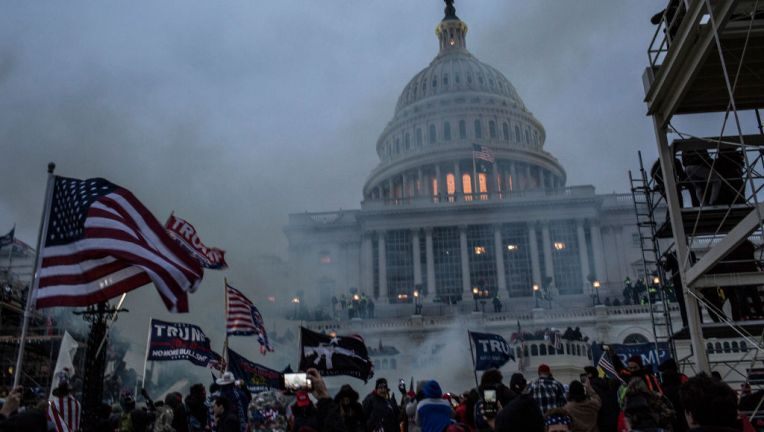
Law enforcement officials did not respond with urgency to a cascade of warnings about violence on Jan. 6
- Alerts were raised by local officials, FBI informants, social media companies, former national security officials, researchers, lawmakers and tipsters.
- The FBI received numerous warnings about Jan. 6 but felt many of the threatening statements were “aspirational” and could not be pursued. In one tip on Dec. 20, a caller told the bureau that Trump supporters were making plans online for violence against lawmakers in Washington, including a threat against Sen. Mitt Romney (R-Utah). The agency concluded the information did not merit further investigation and closed the case within 48 hours.
- One of the biggest efforts to come out of Sept. 11, 2001 — a national network of multi-agency intelligence centers — spotted a flood of Jan. 6 warnings, but federal agencies did not show much interest in its information.
- The FBI limited its own understanding of how extremists were mobilizing when it switched its social media monitoring service on the last weekend of 2020.
Pentagon leaders had acute fears about widespread violence, and some feared Trump could misuse the National Guard to remain in power
- Army Secretary Ryan McCarthy was left rattled by Trump’s firing of senior Pentagon officials just after the election and sought to put guardrails on deployment of the National Guard.
- Then-acting defense secretary Christopher C. Miller did not believe Trump would misuse the military but worried that far-right extremists could bait soldiers into “a Boston Massacre-type situation.” Their fears contributed to a fateful decision to keep soldiers away from the Capitol on Jan. 6.
The Capitol Police was disorganized and unprepared
- The U.S. Capitol Police had been tracking threatening social media posts for weeks but was hampered by poor communication and planning.
- The department’s new head of intelligence concluded on Jan. 3 that Trump supporters had grown desperate to overturn the election and “Congress itself” would be the target. But then-Chief Steven Sund did not have that information when he initiated a last-minute request to bring in National Guard soldiers, one that was swiftly rejected.
Trump’s election lies radicalized his supporters in real time
- As the president exerted pressure on state officials, the Justice Department and his vice president to overturn the results, his public attacks on the vote mobilized his supporters to immediately plot violent acts — discussions that researchers watched unfold online.
During the attack
Escalating danger signs were in full view hours before the Capitol attack but did not trigger a stepped-up security response
- Hundreds of Trump supporters clashed with police at the Washington Monument and the Lincoln Memorial on the morning of Jan. 6, some with shields and gas masks, presaging the violence to come.
- D.C. homeland security employees spotted piles of backpacks left by rallygoers outside the area where the president would speak — a phenomenon the agency had warned a week earlier could be a sign of concealed weapons.
Trump had direct warnings of the risks but stood by for 187 minutes before telling his supporters to go home
- For more than three hours, the president resisted entreaties from House Minority Leader Kevin McCarthy, other Republican lawmakers and numerous White House advisers to urge the mob to disperse, a delay that contributed to harrowing acts of violence.
His allies pressured Pence to reject the election results even after the Capitol siege
- John C. Eastman, an attorney advising Trump, emailed Pence’s lawyer as a shaken Congress was reconvening to argue that the vice president should still reject electors from Arizona and other states.
- Earlier in the day, while the vice president, his family and aides were hiding from the rioters, Eastman emailed Pence’s lawyer to blame the violence on Pence’s refusal to block certification of Biden’s victory.
The FBI was forced to improvise a plan to help take back control of the Capitol
- After the breach, the bureau deployed three tactical teams that were positioned nearby, but they were small, specialized teams and did not bring overwhelming manpower.
- As the riot escalated, acting attorney general Jeffrey Rosen scrambled to keep up with the deluge of calls from senior government officials and desperate lawmakers.
- Senior Justice Department officials were so uncertain of what was occurring based on chaotic television images that Rosen’s top deputy, Richard Donoghue, went to the Capitol in person to coordinate with lawmakers and law enforcement agencies.
After the attack
Republican efforts to undermine the 2020 election restarted immediately after the Capitol attack
- Eight days after the violence, state Republicans privately discussed their intention to force a review of ballots cast in Maricopa County, Ariz., setting in motion a chaotic process that further sowed doubt in the results and a wave of similar partisan investigations in other states.
False election claims by Trump that spurred the Capitol attack have become a driving force in the Republican Party
- Nearly a third of the 390 GOP candidates around the country who have expressed interest in running for statewide office this cycle have publicly supported a partisan audit of the 2020 vote, downplayed the Jan. 6 attack or directly questioned Biden’s victory.
- They include 10 candidates running for secretary of state, a position with sway over elections in many states.
Trump’s attacks have led to escalating threats of violence
- Election officials in at least 17 states have collectively received hundreds of threats to their personal safety or their lives since Jan. 6, with a concentration in the six states where Trump has focused his attacks on the election results.
- Ominous emails and calls have spiked immediately after the former president and his allies raised new claims.
First responders are struggling with deep trauma
- Those who tried to protect the Capitol are contending with serious physical injuries, nightmares and intense anxiety. “Normal is gone,” said one Capitol Police commander.



